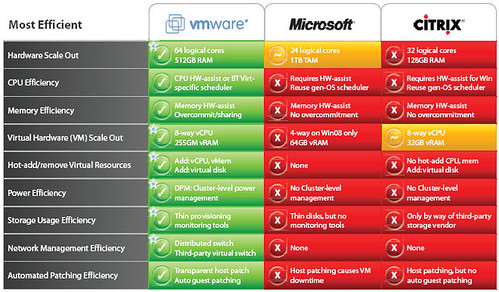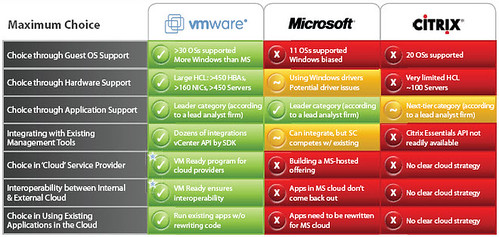I’m not exactly sure where this document came from – I was unable to locate it on the internet, but it looks to have been generated by VMware for the partner or sales channels. I’m an end user so I typically don’t have my hands on sales material. The document summarizes vSphere features, licensing, tiers, and more. It’s not marked VMware company confidential so I’m going to go ahead and post it. Hopefully I won’t find myself begging for forgiveness.
I love the virtualization product comparisons. There’s a lot of smoke in the air coming from all three major virtualization camps. I think the product comparison charts really help answer the questions “Why VMware?” “Why not MS or Citrix?” “Is VMware’s price point worth it?” You bet it is. The data below speaks for itself.



















This is true and absolutely agree with the details you share.
Great document you found. Good job Jason….-:)
Excellent comparisons. Thanks for sharing.
Why not compare with Hyper-V R2 ? 😉
BTW, ESX 4 is not available yet…
I agree with NiTRo. Not sure why everyone is so excited in the comments below. If VMware wants to talk about ESX4, they needs to be comparing it with Hyper-V R2 and Citrix XEN 5.5.
Is VMware really so scared of competition that they are afraid to mention upcoming releases from competition (btw both in beta/RC state now)?
Yes. VMWare is very much afraid of comparison. They don’t permit comparing Hypervisors, in fact, they don’t even allow to install VMWare if it will get tested for performance. Even though there is a comparison at http://virtualizationreview.com/articles/2009/03/02/lab-experiment-hypervisors.aspx.
But even though they are not afraid to publish wrong (or not upsolutely right) “facts”. An example: Xen supports near to unlimited RAM and CPUs (actually, 10^64 Bit RAM, 1024 sockets). There are no coded Limits in Xen (see Xen’s Hypervisor Source code). It would be a red flag for VMWare, but there is s small chance to bring it back to Citrix: Citrix supports just 32 CPU cores and 128 GB RAM! But OEMs may support more. Actually, my 12 Xen Servers run on 16 6 Core CPUs (i.E. 96 cores) and use 750 GB RAM. It was set up by a Citrix SE, using the regular Citrix installation CD, so don’t worry about RAM and Cores.
And there would be even much more to say 😛 But VMWare versus Xen is a kind of religious conflict, rather like Catholics versus Protestants in Belfast. So it’s not worth spending time on pointing out facts.
I’d say: Xen is faster, VMWare got better tools (but Citrix improves). And VMWare is not able to virtualize terminal servers (same machines supported just 40% of users, that’s why we changed terminal servers to Xen).
Thank you for the feedback Johannes. You are right, it does sometimes resemble a comparison of religions. Regarding your last paragraph, virtualization of Terminal Services wasn’t very appealing in ESX 2.x but it got a lot better in VI3. I virtualized many prod and non-prod TS boxes in my previous environment with great success and a fraction of the hardware compared to physical. Terminal Servers make great VMware workloads because of the benefit of Content Based Page Sharing. 40+ users on the same server running the same application code is almost a based case scenario for page sharing. In some cases, we were getting more users on virtual Citrix servers than we could fit on physical Citrix servers due to the memory sharing benefits.